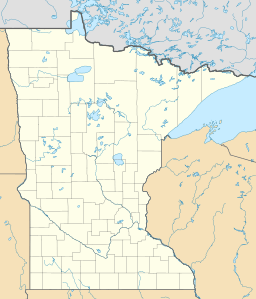Christina Lake (Minnesota) facts for kids
Quick facts for kids Christina Lake |
|
|---|---|
| Location | Douglas / Grant counties, Minnesota, United States |
| Coordinates | 46°05′33″N 95°44′39″W / 46.09250°N 95.74417°W |
| Basin countries | United States |
| Surface area | 3,978 acres (1,610 ha) |
| Average depth | 4 ft (1.2 m) |
| Max. depth | 14 ft (4.3 m) |
| Surface elevation | 1,214 ft (370 m) |
| Settlements | Ashby, Melby |
Christina Lake is a cool lake in west-central Minnesota. Most of it is in Douglas County, but a small part reaches into Grant County. This lake is about 3,978 acres (16.10 km2) big, which is like 3,000 football fields! It's usually about 4 ft (1.2 m) deep.
Christina Lake is super important for birds, especially a type of duck called the canvasback. It's known as a Wildlife Management Lake. This means it's a special place where thousands of migrating ducks and other water birds stop to rest. You can see huge groups of birds floating on the water during their long journeys. This makes the lake a top spot for people who love watching birds.
There is one public spot to get to the lake. It's on the southwest side, right off State Highway 82. The Minnesota Department of Natural Resources takes care of this area.
Contents
Lake Christina: A Look at Its Past
How Christina Lake Got Its Name
Christina Lake was likely named after a brave pioneer woman. She was of Swedish background. This is what Warren Upham, a historian, believed.
Christina Lake: A Canvasback Paradise
In the 1930s and 1940s, Christina Lake was famous. Many people thought it was one of the best places in the world for canvasback ducks. Some even said it was as good as Chesapeake Bay! The lake was big and shallow. It had lots of a plant called sago pondweed. This plant was like a magnet for ducks.
At that time, wildlife experts counted many ducks. They saw about 50,000 canvasbacks on the lake each day. Nearly 20 percent of all the canvasbacks in North America visited this lake.
What Happened to the Ducks?
By 1959, things changed. The highest number of canvasbacks seen in one day was only 250. Then, in 1984, during the busiest migration time, only 15 ducks were counted.
The problem was that the lake water became cloudy. This murky water stopped the sago pondweed from growing. Without their favorite food, the ducks had little to eat. Rough fish, like carp, were thought to be causing the cloudy water. They stirred up the lake bottom.
Helping the Lake and the Ducks
In 1987, the DNR took action. They treated the lake to remove the rough fish. They also put an electric barrier in the channel. This barrier stopped fish from nearby Pelican Lake from entering Christina Lake.
These efforts helped a lot! By 1993, the number of ducks bounced back. About 68,000 canvasbacks were seen on the lake.
However, over time, the rough fish came back. So, in 2003, the DNR treated the lake again. This time, they used helicopters to spread the treatment. By 2005, the water was clear again. More ducks returned to the lake. In 2012, the DNR also added a water pump. This pump moves water from Christina Lake to Pelican Lake. This helps to lower the water level. Lower water levels can help the pondweed grow better. Today, the water and pondweed are the best they have been in years.
The Minnesota DNR still watches the lake closely. They work to keep the rough fish numbers low. This helps Christina Lake stay a great home for ducks.
Fish in Christina Lake
Why You Can't Fish Here
Right now, you cannot go fishing in Christina Lake. The lake has had trouble growing large gamefish. Gamefish are fish that people usually like to catch for sport or food. For example, in 2005, a survey found that northern pike were only 2 to 6 pounds.
Fish Kills and Rotenone
The lake has had several "fish kills" over the years. A fish kill is when many fish die at once. The DNR has also used a special treatment called rotenone to help the lake. This treatment helps remove unwanted fish. While it helps the lake's health for ducks, it also means fewer large, older fish.
Fish You Might Find
Even though fishing is closed, many types of fish still live in Christina Lake. These include:


